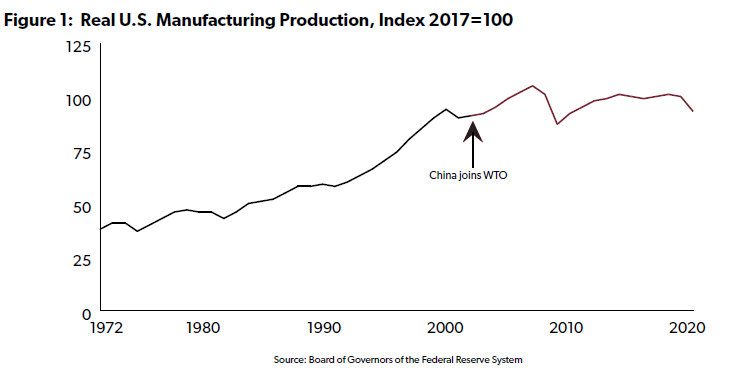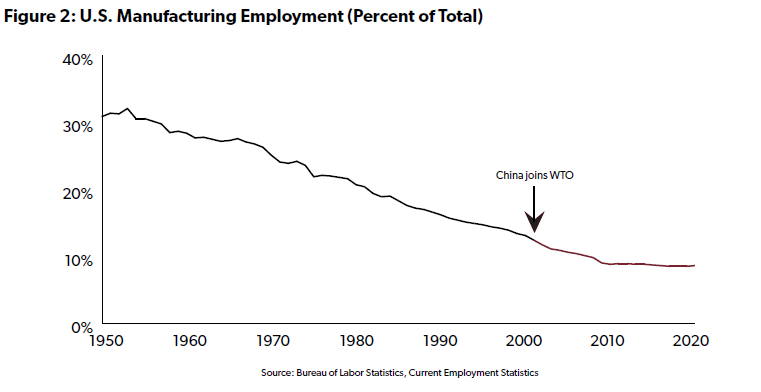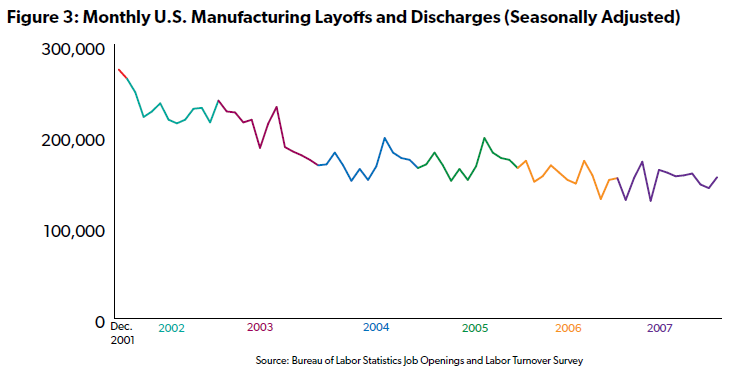(pdf)
December 11, 2021 is the 20th anniversary of China joining the World Trade Organization (WTO). One of the most misunderstood events in recent U.S. economic history, China’s accession to the WTO is often wrongly blamed for causing various American economic maladies. Here are 5 facts about China and the WTO that every policymaker should know.
1. China’s accession to the WTO did not impede U.S. manufacturing strength. Critics of China joining the WTO repeatedly assert that American manufacturing was damaged as a result. That view is categorically incorrect. American manufacturing production has steadily increased over the years, interrupted only by factors entirely unrelated to China’s accession to the WTO such as recessions and the global pandemic.[1] Looking at a graph of U.S. manufacturing output, it would be very difficult to ascertain the year China joined the WTO.

2. China’s accession to the WTO had no significant impact on U.S. manufacturing employment. Similarly, it is impossible to identify the year China joined the WTO by looking at a graph of U.S. manufacturing employment over the years.[2] Manufacturing employment as a share of total employment has steadily declined for decades as technological advances have enabled fewer workers to produce more goods.[3]

3. U.S. manufacturing layoffs declined after China joined the WTO. U.S. Bureau of Labor Statistics data show that there was no increase in U.S. manufacturing layoffs from the time China joined the WTO through the start of the Great Recession[4]. Manufacturing layoffs in the years following China’s accession to the WTO actually trended slightly downward. The fact that layoffs declined even as total manufacturing employment continued the same steady downward trend suggests that manufacturing job losses were primarily driven by workers voluntarily leaving for new jobs in other industries or retiring.

4. There has never been a single academic study showing net job losses due to China joining the WTO. If China’s accession to the WTO led to large-scale U.S. job losses, we would expect to see numerous economic studies of this phenomenon. Instead, there is zero evidence of net U.S. job losses. That doesn’t mean some industries didn’t suffer. But new jobs were created elsewhere, and the overall economic impact on Americans was positive.
For example, the most recent “China Shock” paper from David Autor, David Dorn, and Gordon H. Hanson concludes that, based on research calculating a reduction in consumer prices of 1.25 percent as a result of imports from China, just 6.3 percent of the U.S. population live in commuting zones that experienced declines in personal income per capita of 1.25 percent or more.[5] That would mean 93.7 percent of Americans live in commuting zones where the net welfare effect of trade with China was either neutral or positive.
5. Joining the WTO did not immediately transform China into a market-oriented democracy — but trade has proven more effective than trade barriers. As President Bill Clinton pointed out in 2000: “China is a one-party state that does not tolerate opposition. It does deny citizens fundamental rights of free speech and religious expression. It does defend its interests in the world, and sometimes in ways that are dramatically at odds from our own.”[6] At the time, reformers in China and the United States hoped WTO membership would encourage beneficial economic changes. According to Jin Liqun, China’s vice minister of finance: “WTO membership works like a wrecking ball, smashing whatever is left in the old edifice of the planned economy.”[7]
Unfortunately, the most optimistic hoped-for changes following China’s accession to the WTO largely failed to materialize. But there were some notable improvements. For example, China’s average tariff rate in 2001 was 14.1 percent. By 2019, its average tariff rate was just 2.5 percent, lower than the average U.S. tariff rate.[8] Moreover, a Cato Institute review of completed WTO disputes lodged against China concluded: “In all 22 completed cases, with one exception where a complaint was not pursued, China’s response was to take some action to move toward greater market access.”[9]
In comparison, the track record of tariffs as a tool to achieve change is much worse. Americans have paid more than $113 billion in taxes on goods imported from China as a result of tariffs imposed by President Trump and maintained by President Biden. According to the U.S.-China Economic and Security Review Commission, since those tariffs were imposed China has:
- Increased internal repression in Hong Kong, Xinjiang, and Tibet
- Broadened state intervention in the economy to achieve the Chinese Communist Party’s economic, social, and political goals
- Expanded the capabilities of the People’s Liberation Army, and acted increasingly hostile towards Taiwan in particular[10]
Unfortunately, many people who should know better continue to misstate the economic impact of trade with China. This rhetoric has spilled over into trade proposals that would be counterproductive to U.S. interests, including additional limits on trade with our closest allies. An honest assessment of the impact of China’s accession to the WTO should be the starting point for an effective U.S. response.
[1] “Industrial Production: Manufacturing (NAICS) (IPMAN).” Board of Governors of the Federal Reserve Bank of the U.S. Retrieved from: https://fred.stlouisfed.org/series/IPMAN,
[2] “Employment, Hours, and Earnings from the Current Employment Statistics survey (National).” U.S. Bureau of Labor Statistics. Retrieved from: https://data.bls.gov/PDQWeb/ce.
[3] Hicks, Michael J., and Srikant Devaraj. “The Myth and the Reality of Manufacturing in America,” June 2015 and April 2017. Conexus Indiana and Ball State University Center for Business and Economic Research. Retrieved from: https://conexus.cberdata.org/files/MfgReality.pdf.
[4] “Job Openings and Labor Turnover Survey (JOLTS).” U.S. Bureau of Labor Statistics. Retrieved from: https://data.bls.gov/PDQWeb/jt.
[5] Autor, David, David Dorn, and Gordon H. Hanson. “On the Persistence of the China Shock,” National Bureau of Economic Research, October 2021. Retrieved from: https://www.nber.org/papers/w29401.
[6] President Bill Clinton. “Remarks at the Paul H. Nitze School of Advanced International Studies,” March 8, 2000. Retrieved from: https://www.presidency.ucsb.edu/documents/remarks-the-paul-h-nitze-school-advanced-international-studies.
[7] Davis, Bob. “When the World Opened the Gates of China.: The Wall Street Journal, July 27, 2018. Retrieved from: https://www.wsj.com/articles/when-the-world-opened-the-gates-of-china-1532701482.
[8] “Tariff rate, applied, weighted mean, all products (%), The World Bank. Retrieved from https://data.worldbank.org/indicator/TM.TAX.MRCH.WM.AR.ZS, and “Imports for Consumption: Customs Value and Calculated Duties.” U.S. International Trade Commission. Retrieved from: https://dataweb.usitc.gov/trade.
[9] Bacchus, James, Simon Lester, and Huan Zhu. “Disciplining China’s Trade Practices at the WTO: How WTO Complaints Can Help Make China More Market‐Oriented,” November 15, 2018. Retrieved from: https://www.cato.org/policy-analysis/disciplining-chinas-trade-practices-wto-how-wto-complaints-can-help-make-china-more.
[10] “2021 Report to Congress of the U.S.-China Economic and Security Review Commission,” November 2021. Retrieved from: https://www.uscc.gov/sites/default/files/2021-11/2021_Executive_Summary.pdf.

